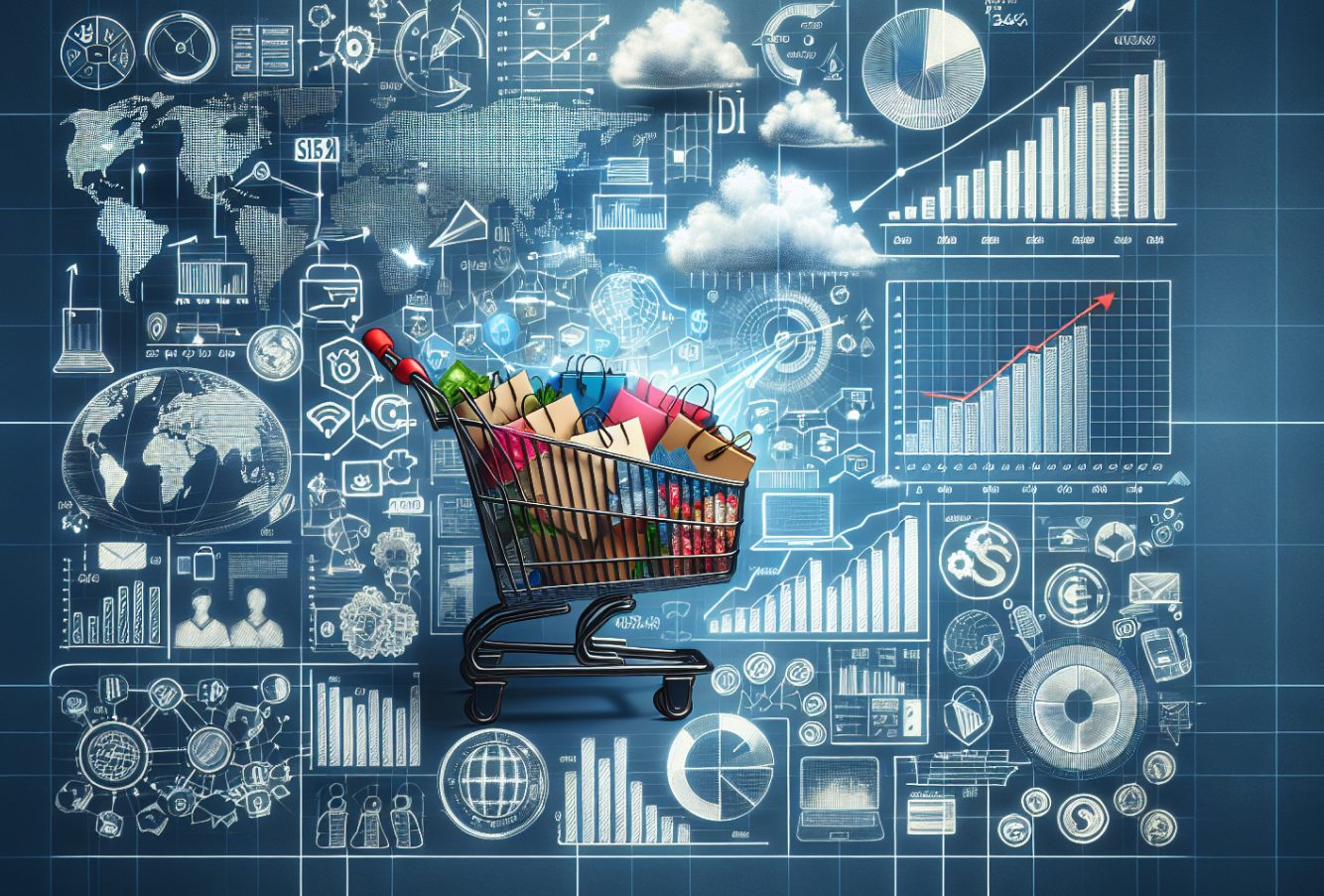The Blueprint of Success: A Deep Dive into E-commerce Business Models
Latest update on 2 May, 2024 by Caspian Ng– Marketing Analyst at FreightAmigo
E-commerce, or electronic commerce, is pivotal in shaping the digital strategy of today’s businesses, dictating how goods and services are sold online. As of 2023, electronic commerce is set to account for about 20% of total global retail sales, highlighting its growing influence in the marketplace. This surge underscores the urgency for businesses to understand the various e-commerce business models, including B2C, B2B, C2C, C2B, B2G, and B2B2C, to stay competitive and drive long-term growth.
This article delves into the intricacies of these six predominant e-commerce business model, providing a comprehensive overview of each and demonstrating their role in the success of electronic commerce endeavors. Understanding these business models not only positions businesses to outperform competitors but also equips them with the knowledge to innovate and adapt in the rapidly evolving digital marketplace.
Want To Compare The Best Express, Air Freight, Sea Freight, Rail Freight & Trucking Rates So As To Have Better Control On Cost?
B2C (Business-to-Consumer)
B2C e-commerce, representing a direct bridge between businesses and end-users, is a dynamic sector of electronic commerce. This model simplifies the traditional retail chain, eliminating intermediaries and directly targeting the consumer, which often results in more competitive pricing and enhanced customer service.
Key Characteristics of B2C E-commerce
- Direct Interaction with End Users: Unlike the B2B model, which involves transactions between businesses, B2C focuses on selling products directly to the consumer for personal use. This direct interaction helps in building stronger customer relationships and brand loyalty.
- Simplified Buyer Journey: The process from discovery to purchase is typically shorter and less complex than in B2B models, allowing for quicker sales cycles and higher conversion rates. Consumers benefit from a streamlined buying experience that can be completed with just a few clicks.
- Uniform Pricing Structures: In B2C transactions, consumers usually encounter set pricing, which contrasts with the negotiated pricing common in B2B models. This straightforward pricing structure simplifies the decision-making process for consumers.
Advantages of B2C E-commerce
- Global Reach: B2C platforms can market and sell to customers around the world, expanding their market far beyond local boundaries.
- Reduced Overhead Costs: With no need for physical stores, B2C can operate with lower overhead, which can translate into lower prices for consumers.
- Data-Driven Marketing: Online B2C businesses gather vast amounts of data on consumer behavior, which can be used to tailor marketing strategies and improve customer experiences.
Challenges in B2C E-commerce
- Website and Payment Processing: Creating a user-friendly website and managing secure payment processes are critical and challenging aspects.
- SEO Mastery: To attract organic traffic, B2C businesses must excel in search engine optimization, a constantly evolving field.
B2B (Business-to-Business)
B2B e-commerce, or business-to-business electronic commerce, involves transactions where companies sell products or services to other businesses rather than to individual consumers. This model is distinguished by its focus on meeting the needs of other companies through a variety of operational and sales approaches, including both vertical and horizontal methodologies.
Understanding B2B E-commerce Dynamics
B2B e-commerce operates through two main frameworks: vertical and horizontal markets. Vertical markets focus on providing specialized goods and services tailored for specific industries, while horizontal markets offer products and services that cater to a broader range of industries. This distinction is crucial for businesses aiming to position themselves strategically in the marketplace.
The Importance of Customer Experience
Recent studies indicate that up to 80% of B2B buying decisions are influenced by the buyer’s direct or indirect customer experience. This highlights the critical role of a user-friendly e-commerce portal, with 87% of B2B buyers willing to pay more for better online experiences. Platforms like BigCommerce have capitalized on this trend by offering B2B editions designed to enhance the shopping experience for business buyers.
Key Advantages of B2B E-commerce
B2B e-commerce offers several significant benefits:
- Automated Sales Processes: Automation in e-commerce helps streamline sales operations, reducing manual entry and speeding up transaction times.
- Reduced Infrastructure Costs: With less reliance on physical sales infrastructure, companies can reduce overhead costs.
- Growth Opportunities: The digital nature of e-commerce allows businesses to scale quickly and reach new markets more effectively.
Strategic Marketing in B2B E-commerce
Effective B2B e-commerce marketing strategies focus on educating potential customers about products and services, encouraging the transition from offline to online channels, and aligning business processes for scalability. These strategies help in addressing common misconceptions such as the belief that B2B customers prefer not to order online or that e-commerce necessitates transparent pricing.
Leveraging B2B E-commerce Platforms
Using specialized B2B e-commerce platforms can provide businesses with enhanced capabilities to manage relationships with suppliers and customers more effectively. These platforms also facilitate selling additional products to existing customers, exploring new market opportunities, and harnessing data analytics to fine-tune marketing and sales strategies.
C2C (Consumer-to-Consumer)
C2C e-commerce, short for Consumer-to-Consumer, represents a dynamic marketplace where consumers sell goods or services directly to other consumers. This model is facilitated by third-party websites or platforms, which play a crucial role in connecting buyers and sellers.
Key Features of C2C Platforms
- Transaction Facilitation: These platforms provide the necessary technology and framework for consumers to conduct transactions with each other efficiently.
- Quality Control Mechanisms: To ensure a reliable trading environment, C2C platforms often implement various quality control measures.
- Marketplace Connectivity: They offer a virtual space where sellers can list their products and buyers can browse and purchase them.
Examples of C2C Business Models
- Auction Platforms: Websites like eBay where consumers can bid on items.
- Service Exchange Platforms: Platforms that allow individuals to offer and seek services, from tutoring to home repairs.
- Goods Exchange Platforms: Sites that facilitate the barter or sale of goods between individuals.
- Payment Platforms: These are integrated within C2C sites to process transactions, supporting various payment methods such as credit cards, PayPal, or bank transfers.
Advantages and Challenges
- Advantages for Marketplace Owners: Operating a C2C platform requires minimal inventory and staffing, significantly reducing overhead costs. Owners can choose their level of involvement, from fully automated systems to more hands-on management.
- Benefits for Sellers and Buyers: Sellers gain access to an easy-to-use platform for reaching customers without hefty marketing costs, while buyers enjoy competitive prices and a diverse array of products.
- Common Challenges: Issues such as establishing trust between parties, ensuring effective communication, and managing shipping logistics are prevalent in C2C transactions.
Strategic Considerations
- Choosing the Right Platform: The decision should be based on specific factors like target audience, product type, and desired platform features.
- Niche Markets: C2C commerce provides an excellent opportunity for businesses to focus on specialized products or services, catering to specific consumer interests or needs.
- Integrated Payment Processing: Ensuring a seamless and secure payment process is crucial for retaining users and facilitating smooth transactions.
By leveraging these elements, C2C e-commerce platforms can create a thriving marketplace that benefits both sellers and buyers, contributing to the broader landscape of electronic commerce.
C2B (Consumer-to-Business)
C2B e-commerce, or Consumer-to-Business electronic commerce, represents a unique inversion of the traditional business model by allowing individuals to offer goods and services directly to companies. This model empowers consumers to create value, setting a stage where personal initiatives can directly meet corporate demand.
Key Players in C2B E-commerce
Independent workers and freelancers are the backbone of the C2B model. They utilize platforms to showcase their skills and services, negotiating terms and pricing directly with businesses. This direct negotiation often results in more favorable terms for the service provider and can lead to innovative collaborations and partnerships.
Benefits for Businesses
Businesses engaging with C2B platforms can tap into a diverse pool of talent and innovative products which might not be available through traditional channels. This access is often more cost-effective and can be scaled up or down according to the company’s needs, providing flexibility not typically found in conventional employment relationships.
Consumer Advantages
For consumers or service providers, C2B e-commerce offers significant flexibility and the potential for higher earnings. Platforms provide a broad audience, removing geographical barriers and allowing providers to reach global businesses. This model also supports a variety of work, from short-term projects to long-term collaborations, all while maintaining independence.
Strategic Implementation in Business
To effectively integrate C2B strategies, businesses should focus on:
- Developing robust feedback channels: To capture valuable consumer insights and adapt services or products accordingly.
- Investing in market research tools: To understand the needs and trends within the consumer market, allowing for better targeting and product development.
Challenges and Considerations
While C2B e-commerce offers numerous advantages, businesses must also navigate potential challenges such as fulfillment inconsistencies and pricing fluctuations. Establishing clear contracts and expectations with consumer suppliers can mitigate these risks.
By leveraging the unique opportunities presented by C2B e-commerce, businesses can enhance their competitive edge, adapt to market changes more swiftly, and foster a customer-centric approach that resonates with modern consumers. This model not only supports business innovation but also contributes to a more dynamic and interconnected market environment.
B2G (Business-to-Government)
B2G e-commerce, standing for Business-to-Government, involves businesses selling products, services, and information directly to government agencies or institutions. This model is distinct from other e-commerce frameworks due to its engagement with the public sector, involving unique challenges and opportunities.
Definition and Scope of B2G E-commerce
B2G e-commerce encapsulates transactions where companies target government agencies as their clients. These transactions often involve large-scale projects that can range from infrastructure development to IT solutions. The U.S. federal government, for instance, has been reported to spend between $18.2 billion and $42.6 billion daily on various contracts, highlighting the substantial market size and the financial potential for businesses in this sector.
Advantages of B2G E-commerce
Engaging in B2G transactions offers several benefits:
- Stability: Contracts with government agencies generally provide stable and reliable revenue streams.
- Scale: Government contracts tend to be larger and more lucrative than many private sector deals.
- Reputation: Successfully executing government contracts can significantly enhance a company’s market credibility and attractiveness to other clients.
Challenges in B2G E-commerce
Despite its advantages, B2G e-commerce comes with its set of challenges:
- Bureaucracy and Slow Processes: Government procedures are often slower and more bureaucratic than those in the private sector.
- Intensive Competition: Many companies vie for government contracts, making the environment highly competitive.
- Regulatory Compliance: Companies must adhere to strict government regulations and standards, which can be more demanding than those in the private sector.
Strategic Approaches for Success in B2G E-commerce
To succeed in the B2G arena, businesses should:
- Understand the Procurement Process: Familiarity with the government’s procurement guidelines and schedules is crucial.
- Invest in Compliance and Quality: Meeting the high standards of government contracts in terms of product quality and regulatory compliance can set a business apart from its competitors.
- Build a Strong Bidding Strategy: Developing a competitive bidding strategy that highlights the company’s strengths and aligns with government goals is essential.
By navigating the complexities of B2G e-commerce and leveraging its opportunities, businesses can tap into a significant source of revenue and growth, contributing to their long-term success in the competitive field of electronic commerce.
B2B2C (Business-to-Business-to-Consumer)
B2B2C e-commerce uniquely combines the B2B and B2C models, allowing a business to provide products or services to another company, which then sells these to the end consumer. This model incorporates three main actors: the original supplier (Business A), the intermediary business (Business B), and the final consumer. A prime example of this model in action is Instacart’s partnerships with grocery stores, which enable the stores to reach a broader customer base efficiently.
Overview of B2B2C E-commerce Dynamics
- Partnership Formation: Businesses collaborate to extend their market reach and consumer access. For instance, a manufacturer might partner with an online retailer to sell its products.
- Consumer Data Access: The manufacturer gains valuable consumer behavior insights from the retailer, enhancing product development and marketing strategies.
- Leveraging Expertise: Manufacturers focus on product innovation while retailers handle marketing and customer relations, optimizing resources and expertise.
Key Benefits of B2B2C E-commerce
- Expanded Market Access: By partnering with other businesses, companies can tap into new customer segments and geographic markets.
- Enhanced Brand Exposure: Each party can leverage the other’s brand strength and market presence, multiplying their visibility.
- Streamlined Costs: Shared marketing and distribution efforts reduce overall costs, benefiting from economies of scale.
Challenges in B2B2C E-commerce
- Data Sharing and Privacy: Coordinating data management between two businesses can be complex, requiring robust privacy safeguards.
- Brand Consistency: Maintaining a unified brand message across different platforms and partners poses a significant challenge.
- Customer Relationship Management: Determining which business owns the customer relationship can lead to conflicts or confusion.
Strategic Implementation
For effective B2B2C e-commerce operations, businesses need to:
- Align Goals and Strategies: Ensure that all parties have aligned objectives and complementary strategies for market engagement.
- Invest in Technology: Robust e-commerce platforms that can handle complex transactions between businesses and consumers are crucial.
- Focus on Customer Experience: Seamless integration of services and a consistent customer journey across all touchpoints are vital for retaining customer loyalty.
By understanding and navigating the complexities of B2B2C e-commerce, businesses can unlock new growth avenues, enhance customer reach, and build stronger brand alliances in the digital marketplace. This model not only facilitates efficient resource utilization but also fosters innovative collaborations that can redefine market dynamics.
Conclusion
Across the spectrum of e-commerce business models, from the direct, dynamic exchanges of B2C to the intricate, interconnected operations of B2B, and the innovative landscapes of C2C and C2B, the digital marketplace continues to evolve at a remarkable pace. Each model presents its unique advantages, challenges, and strategic considerations but collectively contributes to the robust and versatile fabric of global e-commerce. Understanding these models is not just beneficial; it’s essential for any entity looking to navigate the complexities of online commerce effectively. In the context of further exploring and engaging with the digital marketplace, businesses poised for growth in e-commerce can benefit significantly from tailoring their strategies to the nuances of these models. For those looking to delve deeper into optimizing their e-commerce operations, incorporating innovative logistics solutions is a step towards achieving streamlined efficiency and market competitiveness. As we continue to witness the reshaping of global commerce through digital platforms, the potential for businesses to innovate, expand, and thrive has never been greater, underlining the significance of these e-commerce models in paving the path forward.
If you are interested in delving deeper into the various types of business models and exploring how they can transform your organization, please go to the FreightAmigo Page and book a demo.
===
Read More:
Prohibited and Restricted Items: Shipping from Hong Kong to Singapore
Navigating the Asian Market: Maximizing Profit with Strategic Imports from Southeast Asia
===
If you have any inquiries on logistics/supply chain, feel free to contact FreightAmigo now:
Chat with us online OR
Phone : +852 28121686
WhatsApp: +852 27467829









































